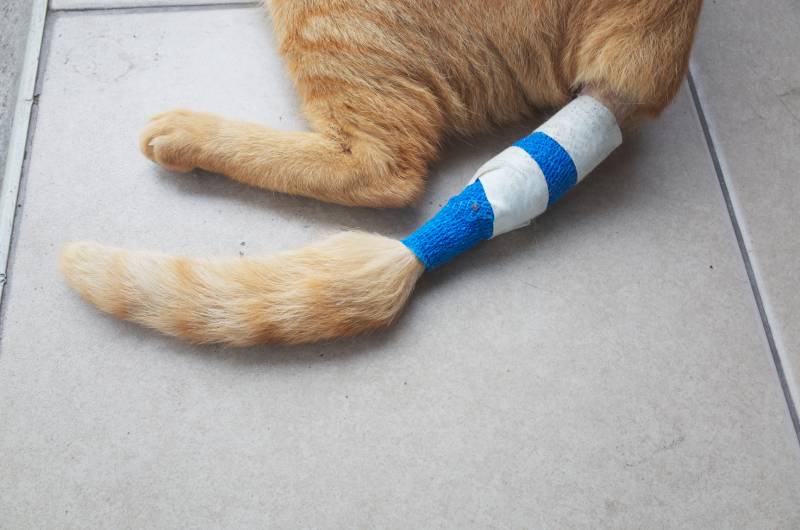
Can cats break their tails? Absolutely—and it’s a veterinary emergency. This type of injury can happen for a variety of reasons. But just because a tail is wounded, it doesn’t necessarily mean that it’s actually broken.
The only way you can know for sure is by getting the appropriate care for your kitty at a veterinary clinic. In this article, we will discuss how your cat can injure or break their tail and how you can help them heal.

The 5 Tips to Treat a Broken Tail
1. Go to Your Vet Immediately
If you think your cat’s tail is broken, go to your vet without delay. Don’t wait to see how bad it gets before you decide to get help and don’t try to treat it yourself. A tail injury can be a simple fix, but it can also be excruciatingly painful and even dangerous for your cat if untreated.
Never attempt to care for a cat’s injuries by bandaging or handling them until you receive medical guidance.
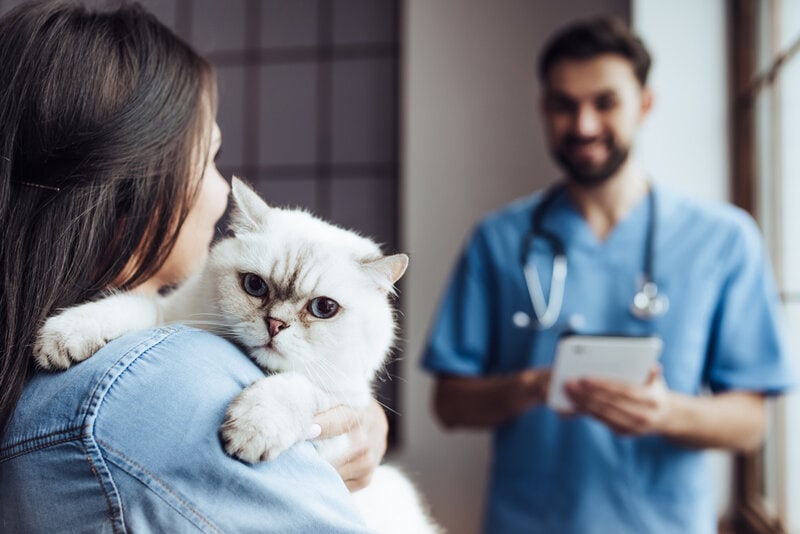
2. Treat Based on Veterinary Guidance
Your veterinarian will examine the tail and determine if x-rays are necessary. If there is also tearing of skin, you might have to administer medications or care for the wound as directed by your vet.
Whether the tail is broken or not you will need to keep your cat rested while they recover from injury. This will involve keeping your cat comfortable and stress-free. The first several weeks will definitely be the hardest, as this is when the injury is still causing a lot of pain and healing rapidly. True breaks will take longer to heal than a dislocation or skin wound in most cases. In some cases, complications mean that amputation of the tail is the best option for your cat.
3. Take Your Cat to All Required Checkups
You must keep up with all recommended vet visits whenever your cat has a broken bone or any injury. This will ensure that your cat is healing properly and that there is no sign of infection or worsening of the injury.
If there is any change requiring your vet needs to adjust medications or treatments, they can do so at this time.
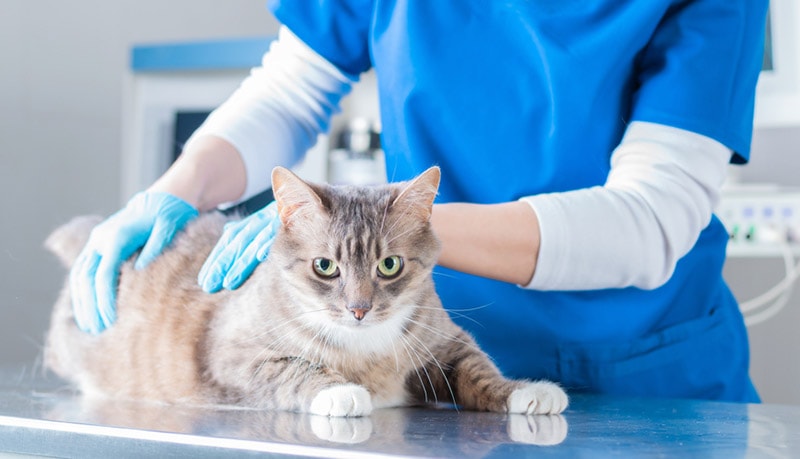
4. Monitor Your Cat Closely
Be sure to keep an eye on your cat during this time. If you notice any behavioral or physical changes, return them to your veterinarian immediately. While uncommon, they can experience shock, infection, and other potentially problematic roadblocks during healing. Sometimes their medication doesn’t agree with them and sometimes they are simply in pain and need further pain relief. If your cat is vomiting or has bouts of diarrhea this could be a side effect of pain medications or other treatments. You need to run any of these issues past your vet’s office.
5. Keep Your Cat Hydrated and Well-Fed
As with any injury, your cat’s body will be working extra hard to heal itself. During this time, proper hydration and quality nutrition are very important.
If your cat lacks appetite during this time, you can always try to stimulate them by giving them wet canned cat food or pouring broth over their dry kibble. These aromatic stimulators will enhance your cat’s appetite and encourage them to eat.
Keep fresh water around, and encourage them to drink!


Types of Tail Damage
There are various kinds of tail damage. What might initially look like a break, also called a fracture, might be a sprain or dislocation. This is another reason why it is imperative to get to your vet immediately. Each injury requires different treatment, and some are more problematic than others.
Let’s talk about the two most common tail injuries and how vets typically fix them.
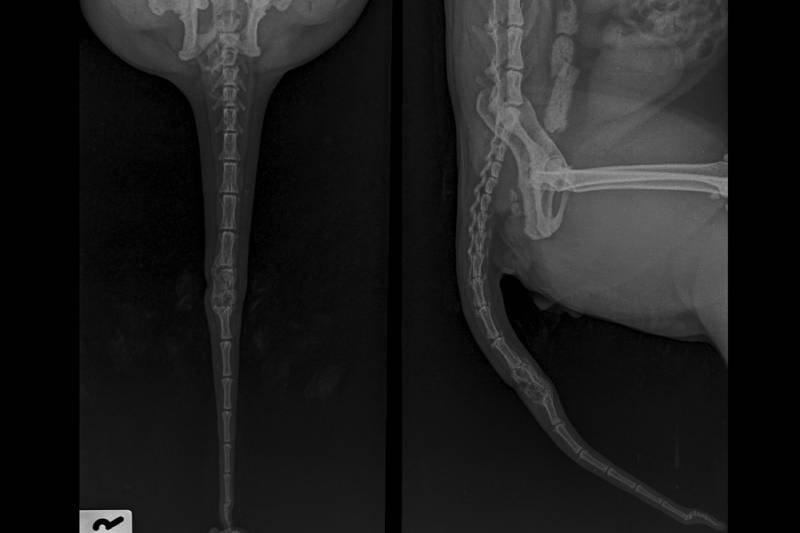
Dislocations
Dislocations occur anywhere in the tail. When a dislocation happens, the connecting vertebrae of the tail are moved out of alignment and the connecting tissues damaged. Typically, this type of injury happens if a cat’s tail is accidentally stepped on, pulled, yanked, or caught in a door.
Some signs of a dislocated tail include:
How Dislocations Are Treated
Your veterinarian will advise you on medications, surgery or any physical therapy that will be required. Often, your vet will prescribe anti-inflammatory or pain medications to soothe the injury. Only give your cat medications prescribed to them and never give human anti-inflammatory medications.
Tail dislocations can be complicated by nerve damage.
Nerve Damage
Tail injuries that occur close to the base of the tail or pelvis have the potential to affect more than just the nerves of the tail. Sometimes the nerves going to the hind legs, bladder or anus are damaged. This can lead to weakness in the hind legs and loss of bladder or bowel control. While damage to the nerves supplying the tail is not good, nerve damage higher up close to the pelvis is much more serious.
Sometimes, if the damage is only mild, nerve damage can improve over time. In more severe cases the damage can be permanent.

Fractures/Breaks
Fractures and breaks occur when the bones are damaged, split, splinter, or are crushed. This may happen in a road traffic accident or from being trapped. Typically fractures at the tip of the tail usually heal well without any surgical treatment. However, the more severe the break, the more involved the therapy. Again your veterinarian will advise you on medications and treatments required.
Signs of a broken tail include:

FAQs
Can Cats Move Broken Tails?
Often if the cat’s tail is truly broken, they won’t really be able to move it. The more severe the break, the less mobile the tail will be. However, if the break occurs towards the tip of the tail, your cat might have more control over tail movement.
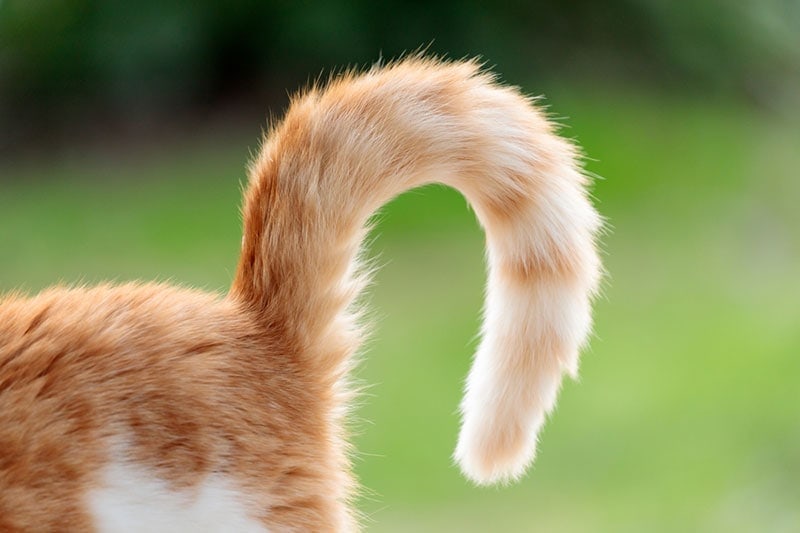
Will Vets Amputate Tails?
Vets will amputate tails if it is the best option for your cat, but it is not always the first line of action. Most tail breaks or fractures are minor in nature and heal with proper treatment. However, there may be situations where the injury is so severe that the tail should be amputated.
If your vet determines that amputation is the right plan of action, you will need to be financially prepared for the surgery. If you have pet insurance, your insurance will cover most of the cost, but you may still be left with a pretty hefty bill.
According to HowMuchIsIt.org, a tail amputation for a cat can cost as little as $500 to as much as $1,100. This greatly depends on the complexity of the surgery, particular vet charges, and complications during surgery. Increased levels of care such as doing blood tests or providing fluids to your cat can also increase costs.
Importance of Insurance or Coverage
Vet bills can be very costly, especially for emergency visits. You might never anticipate a broken tail, so this could come as quite a surprise. To help yourself better prepare for these types of emergencies, pet insurance is widely available now to many owners.
Each type of pet insurance has its own perks and works for a variety of budgets. We encourage you to explore the different options, so you are never put in a predicament where you can’t financially treat your animal.
What If I Can’t Afford Treatment?
If your cat’s tail requires amputation or extensive treatment and you can’t afford it, your vet can speak with you about alternative financial assistance. There are tons of support programs available to owners. Borrowing money from friends and family is a good option if possible.
Also, feel free to look into animal shelters and nonprofit organizations. Often, these places have affordable vet care for these types of situations.

Complications of Broken Tails
Likelihood of Nerve Damage
If your cat’s tail is dislocated or broken, it can cause permanent or transient nerve damage. There are a lot of sensitive nerves that run through your cat’s tail. Think of it as the extension of a spinal cord.
So, if the tail is wounded in any way, it can have a lot of nerve changes as a consequence. Cats can live without their tails however, if the nerves supplying the hind legs, bladder or anus are affected this will impact their quality of life.
Treating Open Wounds on Tails
If your cat has any open wounds on their tail due to injury, your vet might prescribe some topical treatments or medication. Iodine solutions such as Betadine are a safe antiseptic to use on cats.
Length of Time to Heal Wounded Tails
Every wounded tail can take a different length of time to heal, depending on the cause of injury and the severity. Surprisingly, a full recovery of a broken tail can take from 6 weeks up to 6 months. It is essential to see your vet as recommended to ensure healing is going smoothly.
Keeping Your Cat Rested While They Heal
Depending on how your cat’s tail is treated, you need to keep them well rested during the healing process. Follow your veterinarians instructions as some cats will need strict cage rest while others may be able to walk around a small room.
Keeping their stress levels down and preventing them from sudden movements will aid in healing. If your cat is unable to be confined safely, speak to your veterinarian about your concerns. Too much activity could further damage your cat’s tail or even prolong the healing process.

Conclusion
Your cat breaking its tail can be traumatic for both you and your kitty. The best thing you can do is follow your vet’s guidance on how to help your pal heal. It might take a while for them to be fully back to normal.
But hopefully, with the right medical treatment, they will be back to normal in no time. Remember never to try to heal a broken tail on your own. How your vet will treat the broken tail will depend greatly on where it is broken and how severely it is injured.
Featured Image Credit: Tanakorn Akkarakulchai, Shutterstock


